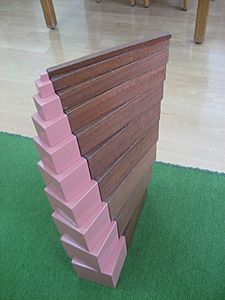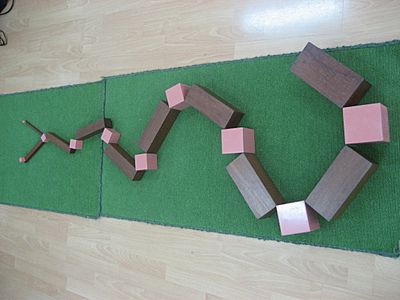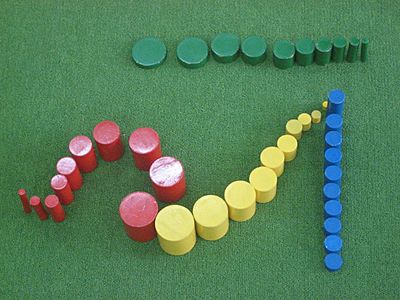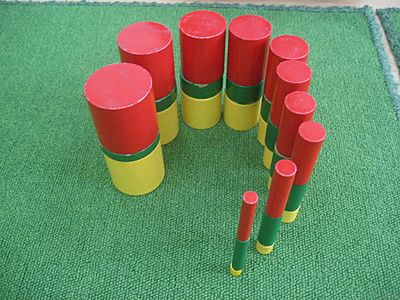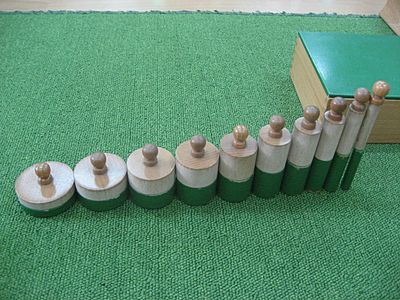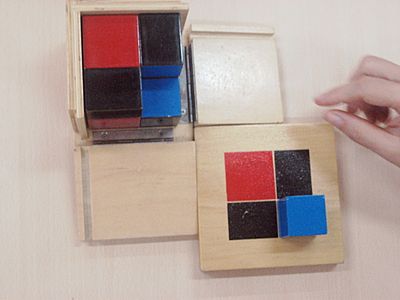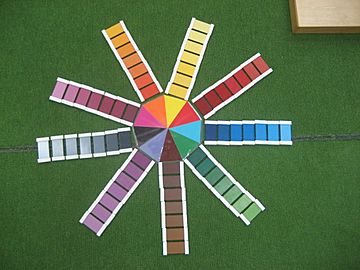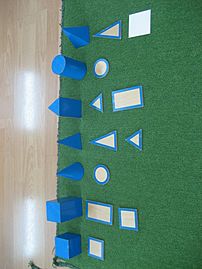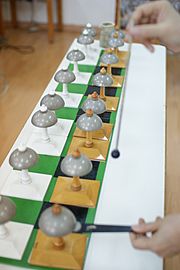Montessori sensorial materials facts for kids
Montessori sensorial materials are special tools used in Montessori classrooms. They help children learn about the world using their five senses: sight, touch, hearing, smell, and taste. These materials are often the next step after children learn practical life skills.
A cool thing about these materials is they have "control of error." This means kids can check their own work to see if they did it right, instead of always asking a teacher. This helps children become more independent and better at solving problems on their own.
Contents
What Are Cylinder Blocks?
Cylinder blocks are sets of ten wooden cylinders. They come in different sizes and fit into a special wooden block. To take them out, children naturally use a three-finger grip, which is the same way they hold a pencil.
The main activity with these blocks is taking the cylinders out and putting them back in the correct holes. If a cylinder doesn't fit, the child knows they made a mistake. This helps them learn to match sizes and shapes.
Discovering the Pink Tower
The pink tower is made of ten pink cubes. Each cube is a different size, starting from 1 centimeter up to 10 centimeters. This material helps children understand the ideas of "big" and "small."
Children start by placing the largest cube on the floor. Then, they stack the next largest cube on top, and so on, until all ten cubes form a tower.
If the cubes are stacked incorrectly, it's easy to see the mistake. This visual "control of error" helps children fix their own work. The cubes are designed so that if you line them up in a corner, you can see how each smaller cube fits perfectly on the edge of the one below it.
Exploring the Broad Stair
The broad stair, also called the Brown Stair, teaches children about "thick" and "thin." It has ten wooden prisms, which are like long blocks, usually stained brown. Each stair is 20 centimeters long and changes in thickness from 1 to 10 centimeters. When you put them together from thickest to thinnest, they form a smooth staircase.
Sometimes, children use the broad stairs with the pink tower. This lets them create many different designs and patterns, using their imagination.
Learning with Red Rods
The red rods are long, red wooden rods that are square-shaped. They are all the same thickness but vary in length. The shortest rod is 10 centimeters long, and the longest is one meter (100 centimeters) long. Each rod is 2.5 centimeters wide and tall. By holding the ends of the rods with two hands, children learn about "long" and "short."
Understanding Colored Cylinders
Colored cylinders are also known as knobless cylinders. They have the exact same sizes as the cylinder blocks, but they don't have knobs.
There are four boxes of these cylinders, each with a different color and pattern:
- Yellow cylinders: These change in both height and width. The shortest cylinder is the thinnest, and the tallest cylinder is the thickest.
- Red cylinders: These are all the same height but vary in width.
- Blue cylinders: These are all the same width but vary in height.
- Green cylinders: These also change in height and width. However, the shortest cylinder is the thickest, and the tallest cylinder is the thinnest.
Children can do many activities with these cylinders. They can match them with the cylinder blocks, stack them to build towers, or arrange them by size to create different patterns. When the yellow, red, and green cylinders are stacked correctly, they all reach the same height.
Exploring the Binomial Cube
The binomial cube is a special cube made of eight smaller pieces. These pieces include: one red cube, three black and red prisms, three black and blue prisms, and one blue cube.
The pieces are stored in a box that has two sides that open. The colorful pattern of the cube is painted on the outside of the box, showing how the pieces fit together.
For younger children (ages 3-6), this material is used for sensory learning. It helps them understand how different shapes fit together. Later, in elementary school, it becomes a tool for learning about math, especially about cube roots.
What is the Trinomial Cube?
The trinomial cube is similar to the binomial cube but has more pieces. It includes:
- One red cube and six black and red prisms (different sizes).
- One blue cube and six black and blue prisms (different sizes).
- One yellow cube and six black and yellow prisms (different sizes).
- Six black prisms (all the same size).
Like the binomial cube, this material helps children understand how different shapes and colors fit together. It's a hands-on way to explore complex patterns.
Other Montessori Materials
There are many other Montessori sensorial materials that help children learn through their senses. Teachers around the world are always exploring and developing new ones. Some other popular materials include:
- Sphere
- Cone
- Ovoid
- Ellipsoid
- Triangle-based pyramid
- Square-based pyramid
- Cube
- Cylinder
- Rectangular prism
- Triangular prism


